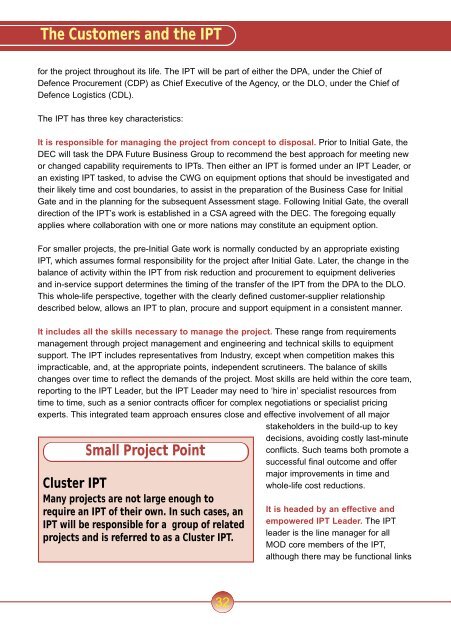The Acquisition Handbook
The Acquisition Handbook
The Acquisition Handbook
- No tags were found...
You also want an ePaper? Increase the reach of your titles
YUMPU automatically turns print PDFs into web optimized ePapers that Google loves.
<strong>The</strong> Customers and the IPTfor the project throughout its life. <strong>The</strong> IPT will be part of either the DPA, under the Chief ofDefence Procurement (CDP) as Chief Executive of the Agency, or the DLO, under the Chief ofDefence Logistics (CDL).<strong>The</strong> IPT has three key characteristics:It is responsible for managing the project from concept to disposal. Prior to Initial Gate, theDEC will task the DPA Future Business Group to recommend the best approach for meeting newor changed capability requirements to IPTs. <strong>The</strong>n either an IPT is formed under an IPT Leader, oran existing IPT tasked, to advise the CWG on equipment options that should be investigated andtheir likely time and cost boundaries, to assist in the preparation of the Business Case for InitialGate and in the planning for the subsequent Assessment stage. Following Initial Gate, the overalldirection of the IPT’s work is established in a CSA agreed with the DEC. <strong>The</strong> foregoing equallyapplies where collaboration with one or more nations may constitute an equipment option.For smaller projects, the pre-Initial Gate work is normally conducted by an appropriate existingIPT, which assumes formal responsibility for the project after Initial Gate. Later, the change in thebalance of activity within the IPT from risk reduction and procurement to equipment deliveriesand in-service support determines the timing of the transfer of the IPT from the DPA to the DLO.This whole-life perspective, together with the clearly defined customer-supplier relationshipdescribed below, allows an IPT to plan, procure and support equipment in a consistent manner.It includes all the skills necessary to manage the project. <strong>The</strong>se range from requirementsmanagement through project management and engineering and technical skills to equipmentsupport. <strong>The</strong> IPT includes representatives from Industry, except when competition makes thisimpracticable, and, at the appropriate points, independent scrutineers. <strong>The</strong> balance of skillschanges over time to reflect the demands of the project. Most skills are held within the core team,reporting to the IPT Leader, but the IPT Leader may need to ‘hire in’ specialist resources fromtime to time, such as a senior contracts officer for complex negotiations or specialist pricingexperts. This integrated team approach ensures close and effective involvement of all majorstakeholders in the build-up to keydecisions, avoiding costly last-minuteSmall Project PointCluster IPTMany projects are not large enough torequire an IPT of their own. In such cases, anIPT will be responsible for a group of relatedprojects and is referred to as a Cluster IPT.conflicts. Such teams both promote asuccessful final outcome and offermajor improvements in time andwhole-life cost reductions.It is headed by an effective andempowered IPT Leader. <strong>The</strong> IPTleader is the line manager for allMOD core members of the IPT,although there may be functional links32
















